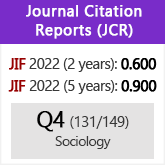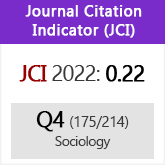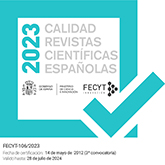Artistic Neighborhoods as Local Base of Global Culture. The Case of the Raval in Barcelona
DOI:
https://doi.org/10.3989/ris.2008.i51.114Keywords:
Artistic neighborhood, Cultural District, Cultural Policy, Urban RenewalAbstract
Artistic neighborhoods, one of the urban phenomenons most characteristic of the beginning century, are beoming an important object of study in the social sciences. However the analysis is overly centered on their economic impact or the cultural policies that have contributed to their creation. In this article, we propose to center the study of artistic neighborhoods in the urban, social and artistic dynamics that explain their emergence and rationale for their development. In this sense, we show how the Raval is symbollicaly charged, having an important presence of artists and small cultural businesses, makes up the core of emerging,hybrid and multicultural art in Barcelona and in addition counts on the presence of two cultural institutions oriented towards cultural governance.
Downloads
References
Aisa, F. y M. Vidal (2006), El Raval. Un espai al marge, Barcelona, Editorial Base.
Bianchini, F. (1993), “Remaking European cities: the role of cultural policies”, en Bianchini, Fr., Parkinson, M. (eds), Cultural policy and urban regereration.The West European experience, Manchester, Manchester Univertity Press, pp. 1-20.
Bourdieu, P. (1992), Les règles de l’art, París, Seuil.
Casanova, P. (1999), La république mondieale des lettres, París, Seuil.
Chalvon-Demersay, S. (1984), Le triangle du XIVe. Des nouveaux habitants dans un vieux quartier de Paris, Paris, Éditions de la Maison des sciences de l’homme.
Crane D., et al., (2002), Global culture. Media, arts, policy and globalitzation, Nueva York, Routledge.
Crewe, L. (1996), “Material Culture: Embedded Firms, Organizational Networks and the Local Economic Development of a Fashion Quarter”, Regional Studies, vol. 30, nº 3, junio 1996, pp. 257-272. doi:10.1080/00343409612331349618
Degen, M. (2003), “Fighting for the Global Catwalk: Formalizing Public Life in Castlefield (Manchester) and Diluting Public Life in el Raval (Barcelona)” en International Journal of Urban and Regional Research. Vol. 27-4, pp. 67-80.
Fumaroli, M. (1992), L’État culturel. Essai sur une religion moderne, París, Edition de Fallois.
García Canclini, N. (1991), Culturas híbridas. Estrategias para entrar y salir de la modernidad, México, CNCA/ Grijalbo.
Hall, P. (1998), Cities in civilization, Londres, Phoenix Giant.
Harvey, D. (1990), La condición de la posmodernidad. Investigación sobre los orígenes del cambio cultural, Buenos Aires, Amorrortu editores.
Hannerz, U. (1998), Conexiones transnacionales. Cultura, gente, lugares, Madrid, Cátedra.
Lash, S. y Myles J. (2000), “From Accumulation to Circulation: Young British Artists and Twenty-first Century London”, Ponència en la Conferencia La societat de la Cultura, Barcelona, 6-8 Julio, 2000.
Lorente, P. (2002), “Urban Cultural Policy and Urban Regeneration. The Special Case of Declining Port Cities” en: Diana Crane (ed.). Global Culture. Media, Arts, Policy and Globalization, Nueva York, Routedge, pp. 93-104.
Lotman, H. (1981), La rive gauche. Du front popularie à la guerre froid, París, Seuil
Menger, P-M. (1993), “L’hégémonie parisienne. Économie et politique de la gravitation artistique”, Annales ECS, año 48, nº 6, 1565-1600.
Menger, P-M. (1997), La profession du comédien. Formation, activités et carrières dans la démultiplication de soi, París, La Documentation française.
Martínez Rigol, S. (2000), «El retorn al centre de la ciutat. La reestructuració del Raval entre la renovació i la gentrificació», Tesis doctoral no publicada, Universitat de Barcelona.
Molotch, H. (1996), «LA as a product: how design works in a regional economy», en A.J. Scott y E. Soja (eds.), The city: Los Angeles and urban theory at the end of the twentieth century, Berkeley, University California Press, pp. 225-75.
Montgomery, J. (1995), «The story of Temple Bar: creating Dublin’s cultural quarter», Planning Practice and Reserach. vol. 10, nº 2, pp. 135-172. doi:10.1080/02697459550036685
Montgomery, J. (2003), “Cultural Quarters as Mechanisms for Urban Regeneration. Part 1: Conceptualising Cultural Quarters”, Planning, Practice & Research, vol. 18, No. 4, pp. 293–306. doi:10.1080/1561426042000215614
Mommaas, H. (2004), «Cultural Clusters and the Post-industrial City: Towards the Remapping of Urban Cultural Policy», Urban Studies, Vol. 41, No. 3, pp. 507-532. doi:10.1080/0042098042000178663
Moulin, R. (1983), Le marché de l’art en France, Éditions de Minuit, París.
Moulin, R. (1992), L’artiste, l’institution et le marché, París, Flammarion.
Newman, P. y I. SMITH (2000), «Cultural Production, Place and Politics on the South Bank of Thames», International Journal of Urban and Regional Research, vol. 24 nº1, pp. 9-24. doi:10.1111/1468-2427.00233
Rodríguez Morató, A. (2001), «Una nueva formación cultural: el complejo cultural local», en: Xan Bouzada (coord.), Cultura e desenvolvimento local, Santiago de Compostela, Conselho da Cultura Galega.
Rodríguez Morató, A. (2003) «The Culture Society: A New Place for the Arts in the Twenty-First Century», The Journal of Arts Management, Law, and Society, vol. 32, nº4, 2003, pp. 243-256.
Rius, J. (2002), «Els marxants d’art i l’espai urbà. Una anàlisi sociològica del mercat de l’art a Barcelona», Revista Catalana de Sociologia, nº 17, pp. 149-184.
Rius, J. (2005), «Un nou paradigma de la política cultural. Estudi del cas barceloní ». Tesis doctoral no publicada, Barcelona, UAB –EHES.
Rius, J. (2006), «El MACBA y el CCB. De la regeneración cultural a la gobernanza cultural» Digithum, nº. 8. <http://www.uoc.edu/digithum/8/dt/esp/rius.html>
Rius, J. y A. Rodríguez Morató (2006), «La governança cultural urbana. El cas del cluster cultural del Raval», Working paper, Centre d’Estudis de Sociologia de les Arts i la Cultura (CESAC-Universitat de Barcelona).
Rius, J. y J. Subirats (dir.) (2005), Del Xino Al Raval. Cultura i tranformació social a la Barcelona central, Barcelona, Centre de Cultura Contemporània de Barcelona – Institut d’Edicions.
Scot, A. J. (1990), Metropolis. From Division of Labor to Urban Form, Berkeley, University of California Press.
Scot, A. J. (1999), «The US recorded music industry: on the relations between organisation, location and creativity in the cultural economy», Environment and Planning A, vol. 31, pp. 1965-1984. doi:10.1068/a311965
Scot, A. J. (2000), The Cultural economy of Cities, Londres, Sage publications.
Sennet, R. (1975), Vida urbana e identidad personal, Barcelona, Península.
Simpson, C. (1981), SoHo. The artist in the city, Chicago, The University of Chicago Press.
Vilar, P. (1996), Historia y lleyenda del Barrio Chino, Barcelona, Edicions la Campana.
Wacquant, L. (1992), «Pour en finir avec le mythe des “cithés-ghettos. Les différences entre la France et les États-Unis», Annales de la Recherche Urbaine, nº 54, pp. 20-30.
White, H. y C. White (1991), La carrière des peintres au XIXe siècle, París, Flammarion.
Zukin, S. (1989), Loft living: culture and capital in urban change, New Brunswick, Rutgers University Press.
Downloads
Published
How to Cite
Issue
Section
License
Copyright (c) 2008 Consejo Superior de Investigaciones Científicas (CSIC)

This work is licensed under a Creative Commons Attribution 4.0 International License.
© CSIC. Manuscripts published in both the printed and online versions of this Journal are the property of Consejo Superior de Investigaciones Científicas, and quoting this source is a requirement for any partial or full reproduction.All contents of this electronic edition, except where otherwise noted, are distributed under a “Creative Commons Attribution 4.0 International” (CC BY 4.0) License. You may read here the basic information and the legal text of the license. The indication of the CC BY 4.0 License must be expressly stated in this way when necessary.
Self-archiving in repositories, personal webpages or similar, of any version other than the published by the Editor, is not allowed.

















